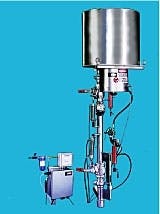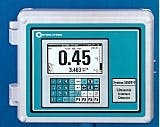New soap stick storage and launching system
Here's the Model 2000 soap stick launcher, which holds 34 soap sticks and will drop on command from a CPU device based on the needs of the well.
The Model 2000 is also available for use in an RTU system. The unit, with field pictures, may be viewed on the internet site at: www.selectindustries.com.
For special well conditions, other types of sticks such as corrosion inhibitor or scale removers may be mixed into the stick turret along with the soap sticks. A pumper may only need to fill the unit every 7-10 days. The unit is specially helpful in cases where it is necessary to climb up the christmas tree on gas wells, the company points out.
Source: Select Industries Inc., Box 2450, Wichita Falls, TX 76307.
Free PC systems handbook
The 2000 preview edition of the PC Systems Handbook is a 124 page handbook available free upon request.
This latest edition, Number 17-1, combines the features of a buyer's guide, a how-to handbook, and a special interest catalog. Detailed, organized charts help make it easy to compare specifications; illustrated tutorials put the experience of company engineers to work for the reader; and an inventory of over 3,000 products helps close the gap between engineers and today's avalanche of new PC products.
The handbook includes a selection of industrial PC systems and data acquisition and control products, with chapters on rack-mount PCs and accessories, portable PCs and PCMCIA technology, flat-panel TFT LCD displays, engineering software, and serial communications.
New in Number 17-1: the MSC Series of ultracompact industrial PC work stations; a line of low-profile all-in-one CPU cards featuring the Intel Pentium III processor; and rack/ panel/bench-mount TFT LCD displays up to 18 in. (diagonal).
Source: Cyber Research Inc., Box 9565, New Haven, CT 06535-0565.
Clamp-on pipeline interface detector
A new temperature and pressure compensated clamp-on pipeline interface detector is designed for precision detection of interfaces of crude oils, multiproduct transportation, and interrefinery pipelines.
The 1010B promises repeatability over a range of products, independent of change in temperature, pressure, or viscosity. Data outputs include API number, density, specific gravity, and product identification number (Liquident).
The 1010B uses ultrasonic and RTD transducers to measure the sonic propagation velocity and liquid temperature of the liquid. These measurements facilitate identification of the liquid by its "sonic signature," which defines its density.
The clamp-on installation helps suit it for new construction, existing pipelines, and replacement of in-line densitometers.
Available in NEMA 4X and NEMA 7 configurations, the interface detector has FM, CSA, and Cenelec safety approvals.
Source: Controlotron Corp., 155 Plant Ave., Hauppauge, NY 11788.
FAS 133 compliant system
This new system helps enable energy companies comply with new Financial Accounting Standards Board (FASB) requirements. FASB issued Statement No. 133, Accounting for Derivative Instruments and Hedging Activities, in June 1998, calling for all derivatives to be reported on balance sheets at fair market value beginning with the first fiscal year following June 15, 2000.
The new FAS 133 module, which can be fully integrated with the Epsilon energy solutions suite or purchased as a stand-alone system, will allow energy companies to correctly report their derivatives positions in compliance with FASB 133 requirements. The goal of Statement 133 is to develop a common framework for derivatives accounting, which means that derivatives must be recognized as assets or liabilities and listed on a company's balance sheet.
Source: SunGard Energy Systems, 901 South Mopac Expressway, Bldg. V, Suite 220, Austin, TX 78746.




